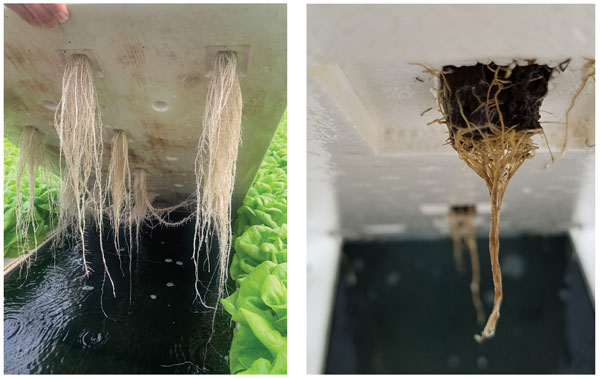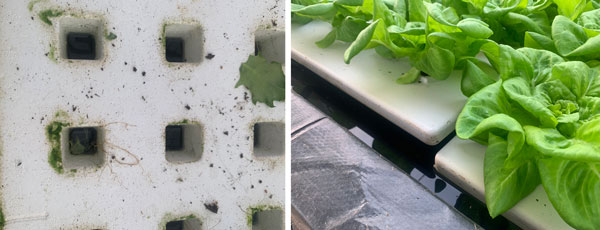2/1/2024
Root Disease Management in Hydroponic Systems
Jean Williams-Woodward

While visiting a deep-water hydroponic producer of lettuce and other leafy greens, I was asked a lot of questions concerning Pythium root disease management within their pond system. The grower wasn’t having any Pythium problems at that time, but they wanted to keep it this way (Figure 1).
Figure 1: Healthy, white lettuce roots grown in deep-water pond production.
Figure 2. Darkly discolored lettuce roots due to black root rot infection caused by the fungus Berkeleyomcyes basicola (formerly Thielaviopsis basicola). Pythium infection also causes darkly discolored, soft roots.
Root disease is always a concern within any hydroponic system. The problem with providing a specific program to manage root disease for all hydroponic growers is that almost every grower and system is different. There’s deep water raft production, nutrient film (NFT) in channels and coir-based grow bag culture. There are also differences in range size and recirculating water interdependence. Some deep-water ponds are independent on their own system, whereas others are connected and water is circulated among multiple ponds over an entire greenhouse range. The bottom line is that I can give general recommendations in managing root diseases, but what’s a viable option for some may not be practical for others.
What to watch for
The primary root pathogens that I’ve encountered are Pythium spp. and Berkeleyomyces basicola (formerly called Thielaviopsis basicola). I’m going to concentrate on Pythium here. Pythium is a “water mold” (an oomycete) that thrives in wet conditions. It infects root tips, especially those damaged by low oxygen and/or high EC levels, and progresses upward, killing the roots. Infected roots are soft and discolored a honey-brown color (Figure 2). What makes Pythium of concern within hydroponic systems is that it produces a spore called a zoospore that can swim in water. Zoospores have two flagella that serve to propel and steer the spore along chemical gradients toward damaged root tips.
The number one question I’m asked is, “Where does Pythium come from?” The answer is that Pythium is everywhere. Pythium is a soil-inhabiting organism. There are also many species of Pythium. Most are saprobic and don’t cause disease. Others are highly pathogenic such as P. aphanidermatum, P. ultimum and P. irregulare. Anywhere water can contact soil, such as in outdoor retention ponds and streams or where soil is introduced into a hydroponic facility intentionally or unintentionally on contaminated shoes, tools or equipment, can introduce Pythium. It’s for this reason that the water source for hydroponics should be clean and preferably well water, which is unlikely to contain Pythium propagules. Keeping surfaces clean, free of plant and soil residue, and following good sanitation practices can reduce Pythium survival and introduction as well.
The one area that must be kept clean is the seeding area. The health of the seedlings directly affects the finished product. Poor quality seedlings will not give expected yield or finishing time. Never reuse rooting mixes or add floor sweepings back into the mix when filling trays. Surfaces and equipment should be disinfected between runs.
More places to look
Within deep-water systems, often the source of root pathogens is within the rafts. Rafts are most often polystyrene, which is porous. As plant roots grow through and around the planting openings, the roots can grow into the polystyrene pores. Rafts must be washed to remove organic debris and then should be heat- treated or disinfected before re-use (Figure 3). However, root pieces and debris can remain embedded within the raft even after treatment. New root growth often follows the channels made into the raft from the previous crop, which can expose the new roots to pathogens remaining in the pores. Plastic rafts can be a solution to this (Figure 4). They’re easier to clean and disinfect, but they’re more expensive.
The water and nutrient solution conditions also affect Pythium populations and survival. High oxygen levels can reduce Pythium zoospore survival. Ensuring adequate aeration within the nutrient solution to achieve saturated dissolved oxygen (8 ppm O2) in the nutrient solution can reduce Pythium survival. Maintaining cooler water temperature (68 to 72F/20 to 22C) is optimal for spinach and lettuce production, and can also slow Pythium survival and infection as well. Low oxygen and warmer root zone temperatures will increase Pythium problems.
 Figure 3. Polystyrene boards are porous. Plant roots harboring pathogens can channel into pores, and be very difficult to clean and disinfect. Contaminated rafts are often a source for root disease pathogens.
Figure 3. Polystyrene boards are porous. Plant roots harboring pathogens can channel into pores, and be very difficult to clean and disinfect. Contaminated rafts are often a source for root disease pathogens.
Figure 4. Plastic rafts are non-porous, easier to clean and disinfect, however, they’re more expensive than polystyrene rafts.
Beneficial microbes build up within deep-water ponds over time that can help reduce root pathogen survival as well. I’ve visited growers with ponds that were filled eight-plus years ago. Their plant production and root growth are good and healthy. As long as Pythium or another root pathogen aren’t introduced on contaminated tools, rafts or plants, there’s no need to drain the ponds and replace the water. For growers with connected ponds, draining and refilling could mean hundreds of thousands of gallons, if not millions, of water, which isn’t feasible. For them, disease prevention is key to maintaining their systems. Microbes can be added to the system by incorporating commercial biocontrol products within the rooting medium or adding products directly to nutrient solutions.
Algae often grows in hydroponic systems that can reduce plant growth. Algae can also harbor shore flies and fungus gnats. These insects are known to spread root pathogen spores. The insects can ingest the spores as they feed on rotting roots. The spores are very resilient and survive within the insect’s digestive system. The insects can then spread the spores to new areas when they defecate. Keeping insect populations and algal growth low will reduce root disease spread.
The key to keeping root disease low is to reduce inoculum buildup within the system. Discard infected plants as soon as any symptoms are seen. The longer infected plants remain within the system, the more Pythium (or any other pathogen) will increase inoculum load and spread to more plants.
For Pythium, zoospores are released into the water from infected roots continuously and can spread through an entire system quickly. Ponds sharing recirculating water systems are rarely drained unless disease pressure is extremely high. These systems should have a water disinfection system in place. Filtration and UV treatment can be very effective. Filtration to remove organic matter and algae and improve water clarity is important to ensure UV treatment is effective. There are other water treatment options such as chlorination, ozonation, copper ionization and the addition of oxidizers (like hydrogen peroxide, peroxyacetic acid).
Care should be used in any system, as some of the treatments can alter nutrient solution pH, interfere with nutrient availability or be phytotoxic to some crops. A good source of information on water treatment options is available in the Waterborne Solutions Tool from the Clean Water3 program
(cleanwater3.org).
Quick Tips
Keys points to remember in managing root pathogens:
● Prevent introduction of pathogens
● Disinfect surfaces, tools and equipment, especially in raft filling and seeding areas
● Wash and disinfect rafts before re-use
● Discard infected plants as soon as seen
● Incorporate beneficial microbes
● Maintain optimal fertility, dissolved oxygen, pH and EC levels in the nutrient solution
● Chill water to 68 to 72F (20 to 22C), especially in the summer months
● Keep algae and insect pests to a minimum
For more grower resources, visit e-gro.org.
This article was reproduced from an e-Gro newsletter with permission from author Jean Williams-Woodward. She’s an extension plant pathologist specializing in ornamental plants and trees, alfalfa and hydroponics at University of Georgia.